Coordination complexes of niobium and tantalum pentahalides with a bulky NHC ligand†
Abstract
The 1 : 1 molar reactions of niobium and tantalum pentahalides with the monodentate NHC ligand 1,3-bis(2,6-diisopropylphenyl)imidazol-2-ylidene (Ipr), in toluene (or benzene) at ca. 80 °C, afforded the complexes NbX5(Ipr) (X = F, 2; Br, 3) and TaX5(Ipr) (X = F, 4; Cl, 5; Br, 6), in generally good yields. Complexes 2–6 represent uncommon cases of stable NHC adducts of metal halides with the metal in an oxidation state higher than +4, and also rare examples of Nb–NHC and Ta–NHC bonding systems. In particular, the X-ray molecular structure determined for 6 provides the unprecedented crystallographic characterization of a tantalum compound with a monodentate NHC ligand. DFT results indicate that the metal–carbon bond in 2–6 is a purely σ one. According to NMR studies (1H, 13C, 93Nb), the formation of 3, 5, 6, as well as the previously communicated NbCl5(Ipr), 1, proceeded with the intermediacy of [MX6]− salts, presumably due to steric reasons. On the other hand, the intermediate formation of MF6− in the pathways to 2 and 4 was not observed, according to 19F (and 93Nb in the case of 2) NMR. DFT calculations were carried out in order to shed light on structural and mechanistic aspects, and allowed to trace possible reaction routes.


 Please wait while we load your content...
Please wait while we load your content...